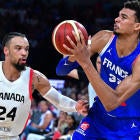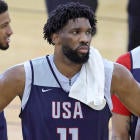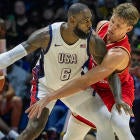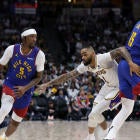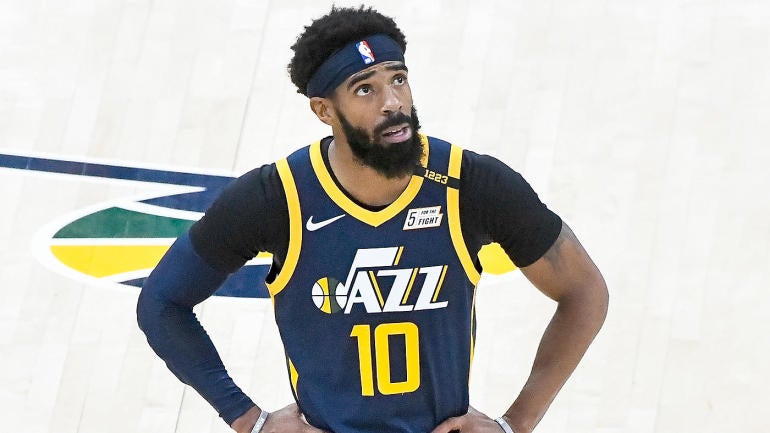
When the NBA All-Star Game was first played in 1951, each roster was made up of 10 players. There were 11 teams in the league at the time, and while teams were allowed to start the season with 11 players on their roster, they were forced to trim down to 10 before the All-Star Game. Now let's do some math. If 20 out of 110 players made it to the first All-Star Game, just over 18 percent of the league was considered worthy of the honor when the idea was first conceived.
As the years passed, steadily fewer players relative to the size of the league made the All-Star Game. Nowadays, on a purely mathematical basis, it's almost four times as difficult to get there as it was when the game was founded.
| Teams | Total roster spots | All-Stars | Percentage of All-Stars | |
|---|---|---|---|---|
1950-51 | 11 | 110 | 20 | 18.2% |
1960-61 | 8 | 88 | 22 | 25% |
1970-71 | 17 | 190 | 28 | 14.7% |
1980-81 | 23 | 253 | 22 | 8.7% |
1990-91 | 27 | 324 | 24 | 7.4% |
2000-01 | 29 | 348 | 24 | 6.8% |
2010-11 | 30 | 450 | 24 | 5.3% |
2020-21 | 30 | 510 | 24 | 4.7% |
The purpose of the All-Star Game, on a broad level, has always been to celebrate the league's best talent. There just happens to be more of it now than ever. The competition to reach the All-Star Game in 2021, with two-way players expanding rosters to 17, is now stiffer than ever. Yet the All-Star Game hasn't adjusted to compensate. It's time to correct that injustice. It's time to expand All-Star rosters from 12 players to 15 players.
You could probably justify higher numbers. For example, if you wanted to maintain the percentage used for the 2001 All-Star Game, widely considered to be one of the most exciting ever played, you'd get 17 slots apiece. That is also the number of roster spots a typical NBA team has, including two-way selections.
But 15 works on a number of levels. Most simply, it is the number of full-time NBA players each team is able to employ, not including two-way contracts. It would also create a nice bit of symmetry with the league's All-NBA system, which honors 15 players. In theory, having 30 All-Stars and 15 All-NBA players would make All-NBA twice as prestigious as an All-Star selection (though conference restrictions make that an imperfect comparison). It would also align the total number of All-Stars with the total number of teams, though, obviously, not all 30 teams would have honorees.
Still, the number itself is less important than the principle guiding it. The NBA has never drawn from a wider talent pool than it does today. All 20 All-Stars in 1951 were born in the United States. In fact, 75 percent of them were born in just six states: New York, Ohio, Pennsylvania, California, Kentucky and Illinois. Nine of this year's 24 selections were born in countries outside of the United States. Players are developing much more quickly nowadays and lasting far longer. The youngest All-Stars in 1951 were Dolph Schayes, Paul Arizin, Ed Macauley and Bob Cousy at age 22. Zion Williamson (20) and Luka Doncic (21) both have them beat in 2021. Bob Davies was the oldest 1951 All-Star at 31. LeBron James is 36. There wasn't a 3-point line in 1951. When Kyle Korver made the team in 2015, 75 percent of his shots came from behind the arc.
The game of basketball bears almost no resemblance to its 1951 counterpart, and the league has proven comfortable acknowledging that in other ways during All-Star Weekend. It's not as though the 1951 event featured a Slam Dunk Contest or used the Elam Ending. Yet when it comes to roster size, the NBA has held at 24 for over three decades, and there isn't an obvious reason why.
The argument that adding more All-Stars would water down the product itself folds the moment you watch a minute of All-Star play. The majority of the game is a glorified exhibition anyway. Expanding rosters wouldn't water down the honor, either. If the league expanded to 15, only 5.8 percent of NBA players would be named All-Stars. That's still less than all but the past two decades or so of NBA history. In fact, one could argue that modern players are getting punished for the league's growth. Mike Conley was not named an All-Star on Tuesday. He is widely considered to be one of the best players in NBA history not to make the team. Had he played in an era in which a higher percentage of the league's players made it, he might not have that stain on his resume.
Conley was far from the only snub. Fan bases across the country (and even in Canada) are upset about their favorite players missing out. If the game is truly for the fans, as is often said, then allowing more of their favorite players to participate would probably be a smart way of engaging them. That it might drive extra television revenue is an added bonus.
But if the game's purpose is to showcase its best talent, the decision to invite less of it proportionally than ever is counterintuitive. Basketball has more All-Star-caliber players than ever. Why are fewer players than ever getting recognized for that?










